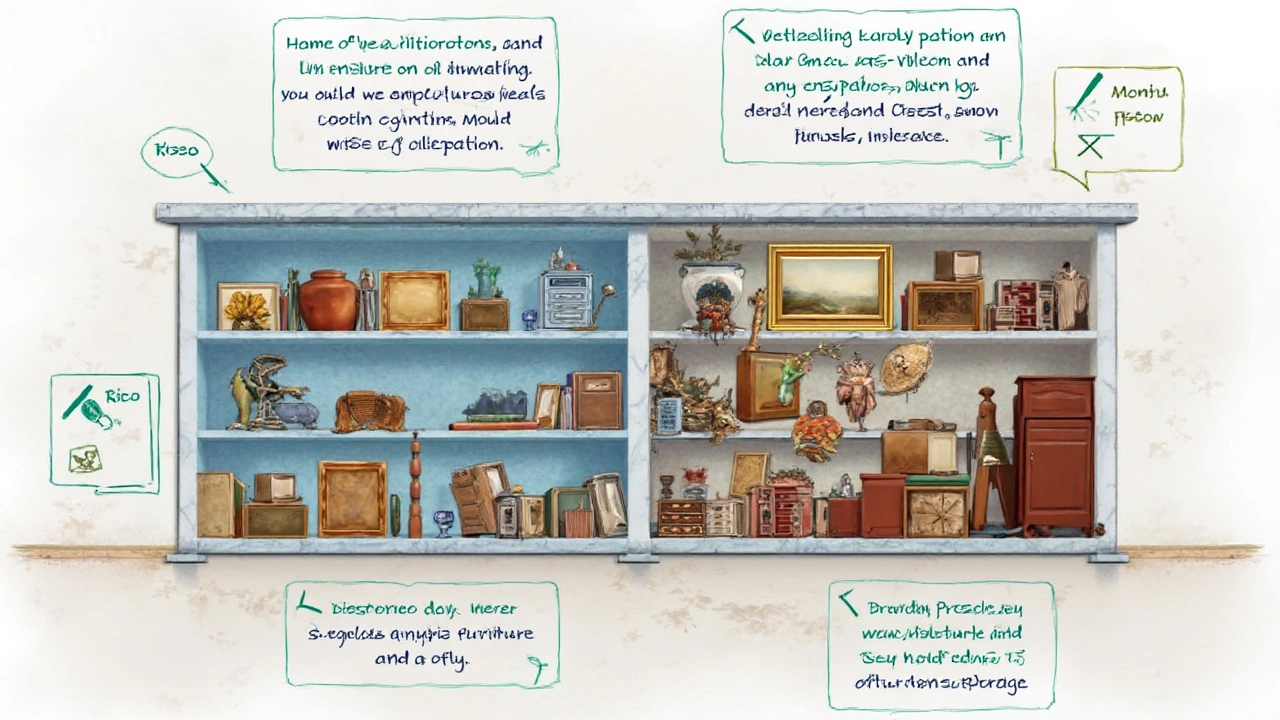 18
May,2025
18
May,2025
If you’ve ever opened a storage unit and been smacked in the face by that weird, musty smell—you’re not alone. That’s usually the first sign mold might be creeping in. Mold is sneaky. Give it some humidity, darkness, and stuff that can soak up moisture, and it will move right in. Think cardboard boxes stacked up, grandma’s couch, or even leather shoes (trust me, I’ve seen it happen to my sister’s boots—total disaster).
Most people think their storage unit is this fortress that keeps everything just as they left it. That’s not always true. Storage units—especially the non-climate-controlled kind—aren’t immune to mold. Changes in temperature, bad air circulation, or even just a rainy day with a few drips can do the trick. Mold spores basically just need water and something to eat, like paper, wood, or fabric. Miss one detail, and suddenly you’ve got a science experiment growing in there.
But here’s the thing: it’s actually not that hard to keep your stuff safe. Know what conditions let mold grow, take a few simple steps, and check things every now and then. You don’t want to open your storage space three months down the road and find your favorite armchair furry with green patches. Keep reading, you’ll see how to keep mold out and your stuff (and sanity) intact.
- Why Mold Shows Up in Storage Units
- How to Spot Mold and Its Early Warnings
- What Kinds of Stuff Are Most at Risk
- How to Keep Your Storage Unit Mold-Free
- Choosing the Right Storage Unit—Stuff to Consider
Why Mold Shows Up in Storage Units
Mold loves two things: moisture and stuff it can eat—like cardboard, fabric, and wood. Storage units sometimes become prime real estate for mold because they get warm, humid, and rarely see fresh air. That’s a perfect setup for mold colonies to pop up.
One big problem is humidity. When the air inside a storage unit gets damp—maybe from rainy weather, or just from the changing seasons—mold spores wake up and start spreading. Non-climate-controlled units are the worst for this. According to the Environmental Protection Agency, mold can start to grow if indoor humidity is consistently over 60%. In my own experience, some storage units feel like a sauna in summer, and that’s a recipe for trouble.
Next up is water leaks. Even a tiny roof drip or condensation from pipes can make a difference. If water seeps into boxes or furniture, it doesn’t take much time before mold goes to work. Storage places don’t always check units quickly, so a small leak can hang around for weeks without anyone knowing.
Poor air circulation is another biggie. Most units get packed floor-to-ceiling, blocking any chance for air to flow. Mold likes stale, still air because it traps moisture. If you’re stacking stuff right up against the walls, you cut off what little ventilation there might be.
Check out the main reasons mold crops up:
- High humidity or damp climate
- Poor or blocked air flow inside the unit
- Leaks—roof, pipes, nearby units, or flooding from outside
- Storing stuff that holds moisture: cardboard boxes, mattresses, upholstered furniture
Here’s some real-world data that puts things in perspective:
| Condition | Chance of Mold Growth |
|---|---|
| Humidity below 55% | Very Low |
| Humidity 60-70% | High (Within Weeks) |
| Carboard/Fabric Storage | Much Higher Risk |
| Standing Water/Leaks | Almost Certain |
If you ever put something a bit damp in storage—say, a mattress after a move or boxes that got rained on—you pretty much jumpstart the problem. Always dry everything first, and try to choose a unit that either stays dry year-round or at least doesn’t trap moisture inside.
How to Spot Mold and Its Early Warnings
Most folks think mold just shows up as fuzzy green or black spots, but sometimes it’s not that obvious—at least at first. Your nose is often the best early-warning system. That musty, damp smell when you open your storage unit is usually your first red flag. Even if you can’t see mold yet, that scent means something’s off. Mold gets started faster than you’d think if the conditions are right. A little leak or even just sticky summer air can do it.
Here's what to look for when you check up on your unit:
- Mold spots: Any colored patches—green, black, gray, and even white—on boxes, walls, fabrics, or furniture.
- Stains: Water marks or streaks mean moisture has sneaked in and that’s like a welcome sign for mold.
- Warping or cracking: If wooden furniture, books, or boxes look bent or warped, mold or moisture may be the culprit.
- Peeling paint or lifting wallpaper: Not every storage unit has wallpaper, but if you’ve got wood paneling or paint, watch for bubbling or peeling.
- Rust: Metal stuff getting rusty usually means high humidity—another friend to mold.
Don’t rely just on your eyes. The nose test is important because mold spores are tiny, and by the time you see a big spot, it’s usually already spread. Keep in mind, lots of folks miss early signs because they don’t visit their unit enough. A quick monthly walk-through makes a huge difference (and saves major headaches).
If you want to be really sure, small humidity sensors are cheap and easy to leave inside. Mold goes wild when humidity is over 60%. Here’s a quick cheat sheet for the signs and risks:
| Early Warning | What It Means | Why Act Fast? |
|---|---|---|
| Musty smell | Hidden mold & trapped moisture | Mold may already be spreading |
| Visible spots | Active mold growth | Damage spreads quickly |
| Water stains/warping | Moisture getting in | Poor storage unit sealing |
| Humidity above 60% | Perfect mold conditions | Immediate risk |
| Rusty metal | High humidity | Warns you before mold shows |
Keep your eyes, nose, and even touch on alert. If you see or smell anything weird, investigate ASAP. Catching it early usually means saving your stuff instead of tossing it.

What Kinds of Stuff Are Most at Risk
Some things practically invite mold to the party. If you’re tossing regular household items into a storage unit, certain pieces are way more likely to get hit by that fuzzy, musty menace. Look at the data—furniture, clothes, and cardboard top the list.
Think about what mold needs: moisture, a surface to land on, and something organic to snack on. Now, check this out:
| Item Type | Why It’s Vulnerable | Risk Level |
|---|---|---|
| Wood Furniture | Wood soaks up and holds onto moisture easily | High |
| Mattresses & Upholstery | Porous, hard to fully dry out, and can trap humidity | High |
| Clothing & Linens | Natural fibers like cotton and wool are mold magnets | Medium-High |
| Cardboard Boxes | Cardboard loves to absorb water and breaks down quickly | High |
| Books & Paper | Organic, absorbs humidity, and mold stains fast | High |
| Leather Goods | Porous and soaks up humidity, hard to clean if infected | Medium-High |
Here’s what’s wild: nearly 60% of people using storage units say they’ve had issues with clothing or bedding going moldy, especially in damp climates.
Electronics aren’t out of the woods, either. While mold won’t eat your TV, it can work its way into little gaps, damaging circuits with trapped moisture. Same for anything with batteries—the danger is less about mold munching, more about the environment causing corrosion and funk.
If you’re stashing family photos, scrapbooks, or anything sentimental, mold danger runs high. Once it’s in paper, mold is nearly impossible to get out without wrecking the item. For anything made of wood or fabric, it’s not just ugly—left unchecked, mold will destroy these things completely.
Your best bet? Store extra-sensitive stuff in sealed plastic bins instead of cardboard. Throw a few silica gel packs in with important items—they suck up excess moisture like magic. If you have furniture, cover it with breathable cloth instead of plastic wrap (plastic traps moisture, which is basically inviting mold to move in).
How to Keep Your Storage Unit Mold-Free
If you want to avoid disaster, keeping your storage unit dry is everything. Mold loves moisture, so you have to control it. The quickest fix? Go for a climate-controlled unit. These actually manage both temperature and humidity, which makes a huge difference—think of them as a safe zone for your stuff during sticky summers or soggy winters.
If climate control isn’t an option, you still have tricks up your sleeve. Here’s what works:
- Mold hates airflow. Use a small battery fan or just leave a little space around boxes and furniture so air can move. Don’t pack things floor-to-ceiling or right against walls.
- Never set anything straight on a concrete floor. Water can seep up and ruin boxes. Try plastic pallets, or even old wooden slats raise your stuff off the ground.
- Grab a few desiccant packs (those little silica gel bags you find in shoes and electronics) or even a tub of DampRid. They soak up extra moisture before mold can get started. Swapping them out every month or two is smart—my daughter Orla can handle this job with no adult help.
- Wrap furniture and soft items in breathable covers. Skip the plastic wrap since it traps moisture inside. Old sheets or special moving pads are way better for keeping things dry and letting air move.
- Check your unit after heavy rain, especially if it's in a low spot or older building. Water leaks cause most mold problems, and the faster you react, the easier the fix.
One more thing: if the unit feels damp or smells weird, trust your nose and don’t ignore it. Mold can grow in a couple of days if you’re not careful. Being proactive is way easier than cleaning up a nasty mess down the road.

Choosing the Right Storage Unit—Stuff to Consider
Picking a storage unit kind of feels like picking a new apartment for your belongings. You want a place that’s safe, clean, and doesn’t secretly breed mold. Here are the things that really matter, especially if you want your stuff to survive without growing fuzz.
Start with climate control. Units with temperature and humidity control are way less risky. Mold and moisture like to show up if there’s a lot of changing temps or humidity swings. Some places keep things steady all year—even on sweltering summer days or icy winter nights. If you’re storing anything made from fabric, wood, leather, or paper, you’ll absolutely want climate control. Trust me, it’s worth the extra few bucks a month.
Location might sound dull, but it matters. If your storage place is near a river, lake, or in a super rainy area, that’s a recipe for moisture problems. I learned this after my cousin lost all her comic books to a soggy ground-level unit after one bad storm. Top floor units might stay drier, especially if flooding is possible, but check that the roof doesn’t leak.
Check out the ventilation. Good airflow means less trapped humidity. Pop open the unit, and if it feels stuffy or smells weird, move on. Some modern facilities have special vents or fans. If you’re getting a traditional metal unit, make sure it’s not fully sealed off—zero air movement is an open invitation for mold to set up shop.
Ask about inspections and maintenance. Reputable storage places aren’t shy about showing off how often they check for leaks, fix seals, or handle mold. If the manager shrugs off your question, that’s a red flag. Look for places that keep things spotless and dry—peek in a few units, not just the one they show you on the tour.
- Avoid units with obvious stains or water marks on floors, walls, or ceilings.
- Stick with newer facilities if possible—old ones might have hidden issues.
- Look for raised floors or units with a slope away from doors so water drains out, not in.
Don’t forget insurance. Even top-notch storage facilities can have problems after freak weather or accidents. Ask about insurance options for your belongings in case mold does slip through the cracks. It’s cheap peace of mind.




